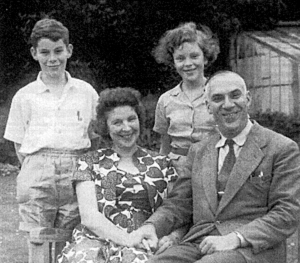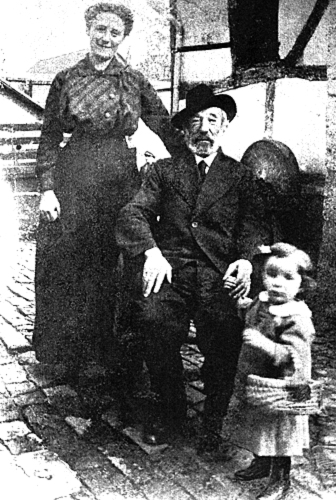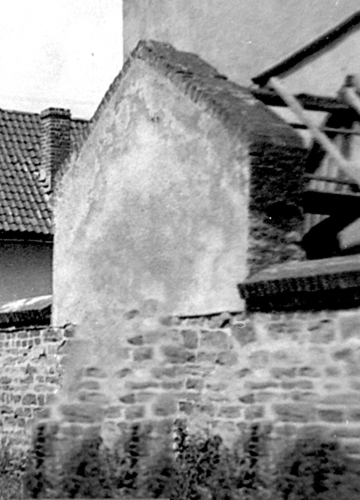You may think that my synagogue, Kol Nefesh, does pretty well to assemble a minyan (the necessary ten men) every Shabbat, week in and week out, from a limited membership, but our achievement pales a little by comparison with another Community. The small shul I refer to was orthodox and therefore counted only males over thirteen, of whom they had just sixteen. Nevertheless, they never failed to gain a minyan every Friday night and Shabbat.
 So where is this unusual Community? Tragically, it no longer exists, but flourished eighty odd years ago in the village of Kommern in the Eifel area of Germany, not far from Cologne. This is where my mother, Emmy Golding, then Emmy Kaufmann, grew up.
So where is this unusual Community? Tragically, it no longer exists, but flourished eighty odd years ago in the village of Kommern in the Eifel area of Germany, not far from Cologne. This is where my mother, Emmy Golding, then Emmy Kaufmann, grew up.
Jews were scattered throughout the villages of the area and each village boasted its own small synagogue. There had originally been thirty Jewish families in Kommern but, by the 1920s, this had been reduced to just twelve. They were on excellent terms with their German neighbours and mixed freely, attending village dances and other celebrations. The line was drawn, however, at intermarriage, which was almost unheard of.
My mother's family had lived in the village for generations and could trace their links back over two hundred years. She was born in the same house that her great-grandfather had owned. Jews made their livings in various ways: one was a watchmaker, a bicycle seller and later a radio retailer; another was a scrap merchant, recycling cloth and metals - you might count him as one of the early "greenies"; yet another had a tanning business, turning rabbit skins into fur collars. My grandfather, like many others, was a cattle dealer and this had been the family business for at least four generations. A highly observant Community, come Shabbat or Yomtov they all hung up their closed signs, apart from one large-scale grain distributor who continued trading. This was very much frowned upon by the rest of the Jewish population.
My mother's earliest memory is of Pesach (Passover). It must have been April 1918 when she was one month short of her fourth birthday.

The First World War had taken away all able-bodied men, including my grandfather, who had departed in 1914, shortly after my mother's birth and been sent to fight for Germany in Russia and Finland. My mother recalls her grandfather, my great- grandfather, sitting at the head of the table, leading the Seder service, surrounded only by women. When her father returned a few months later, having been awarded the Iron Cross and a Finnish medal, she was by no means impressed. Ejected from her mother's bed, she demanded, "Send that man away again!"
Rosh Hashanah (Jewish New Year) signalled a frantic hive of activity. Everyone bought new clothes, travelling to the nearby town of Euskirchen to purchase them. In spite of living in rural surroundings, women were well aware of what was fashionable and made sure that they were dressed in the latest styles. There was a frenzy of baking - challas (Jewish bread), cheesecakes and especially pflaumenkuchen (plum flans) were prepared and then taken to the non-Jewish bakery down the road to be baked in their hotter and more efficient ovens. The five bedrooms of the large half-timbered house would be occupied by visiting family members and others would walk from the surrounding villages to celebrate the New Year together. The festive table would be laden with all manner of meats: a whole pickled tongue, pickled brisket, chicken and various cuts of beef - my grandfather was after all a cattle dealer! The meat was pickled and smoked at home in a special attic room with a large chimney. Vegetables were grown in the kitchen garden. Apple dipped in honey was, of course, an essential part of the meal.
The synagogue itself was run by lay members, as the Community was not large enough to afford a rabbi or chazzan (cantor). My great-grandfather was the honorary chazzan and he, together with a few others who were able to, conducted services. The shul was of traditional design, with an upstairs ladies' gallery but no mechitsah (the partition separating men and women) and seated about a hundred. Not many of the women could read Hebrew, so there was a tendency for them to spend much of the Service talking. My mother's generation was the first to educate its girls properly; she gained a place at a Catholic secondary school, run by Dominican nuns and located some distance away in the nearby town. Lessons were compulsory on Saturdays, so she stayed with a Jewish family from Friday until Saturday evening, and was given special dispensation by the nuns who taught her so that she need not write and break Shabbat. A private Hebrew teacher came each Sunday to Kommern and taught a group of five or six children in a small classroom attached to the shul.
 This same shul was burned to the ground on Kristallnacht in November 1938, when all the Jewish houses were ransacked and my mother, her younger sister and my grandmother walked the streets all night not knowing where to go or who to turn to. My grandfather was taken to Dachau and was only saved by my mother's bravery in taking his war medals to the Gestapo and demanding the release of a man who had fought for his country. Amazingly, her appeal succeeded and he returned five days later.
This same shul was burned to the ground on Kristallnacht in November 1938, when all the Jewish houses were ransacked and my mother, her younger sister and my grandmother walked the streets all night not knowing where to go or who to turn to. My grandfather was taken to Dachau and was only saved by my mother's bravery in taking his war medals to the Gestapo and demanding the release of a man who had fought for his country. Amazingly, her appeal succeeded and he returned five days later.
Things were already beginning to change in the 1920s. Young people were starting to leave the village in order to go to university and were aspiring to the professions rather than the businesses of their parents. This was a world where few people travelled and, for shorter distances, the horse and carriage was the main mode of transport. In 1936 when my mother learned to drive, it was highly unusual for a woman, but my grandfather needed someone to drive the car that pulled his cattle trailer. She became an extremely adept and confident driver and is still at the wheel 73 years later at the age of 95. Nowadays it's a Toyota Yaris rather than a cattle trailer!
It took rather a long time but my mother was eventually called up to read the Torah blessings for the very first time just before her ninetieth birthday, when Robert and I celebrated our Aufruf (the custom of calling the groom up to read the Torah) at Kol Nefesh. She has done so on a number of occasions since then and is delighted to feel she is playing a full part in services. She is convinced that I inherited my singing voice from my chazzan great-grandfather and, when I lead services, her memories of him come flooding back. She has amazing recall of names, places and other details and this article is based on an interview I had with her just a few days ago, during our holiday together. It is worth remembering that she is now one of the very few people who can provide a first-hand account of the life of a Jewish Community in Europe between the two world wars.
LINK:
“Emmy’s Story”: Erinnerung an ein jüdisches Leben in Kommern (Mechernich)
Weiterführende Links:
Wie die Juden von Kommern endlich zu ihrem Gedenkstein kamen
